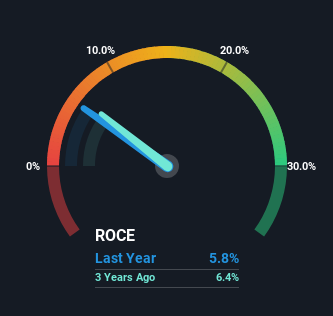Stock Analysis
- United Kingdom
- /
- Commercial Services
- /
- AIM:RST
Investors Could Be Concerned With Restore's (LON:RST) Returns On Capital

If you're looking for a multi-bagger, there's a few things to keep an eye out for. Firstly, we'll want to see a proven return on capital employed (ROCE) that is increasing, and secondly, an expanding base of capital employed. This shows us that it's a compounding machine, able to continually reinvest its earnings back into the business and generate higher returns. Having said that, from a first glance at Restore (LON:RST) we aren't jumping out of our chairs at how returns are trending, but let's have a deeper look.
Return On Capital Employed (ROCE): What Is It?
If you haven't worked with ROCE before, it measures the 'return' (pre-tax profit) a company generates from capital employed in its business. The formula for this calculation on Restore is:
Return on Capital Employed = Earnings Before Interest and Tax (EBIT) ÷ (Total Assets - Current Liabilities)
0.058 = UK£28m ÷ (UK£564m - UK£73m) (Based on the trailing twelve months to June 2023).
So, Restore has an ROCE of 5.8%. Ultimately, that's a low return and it under-performs the Commercial Services industry average of 11%.
View our latest analysis for Restore

Above you can see how the current ROCE for Restore compares to its prior returns on capital, but there's only so much you can tell from the past. If you're interested, you can view the analysts predictions in our free report on analyst forecasts for the company.
So How Is Restore's ROCE Trending?
When we looked at the ROCE trend at Restore, we didn't gain much confidence. Around five years ago the returns on capital were 8.3%, but since then they've fallen to 5.8%. However it looks like Restore might be reinvesting for long term growth because while capital employed has increased, the company's sales haven't changed much in the last 12 months. It's worth keeping an eye on the company's earnings from here on to see if these investments do end up contributing to the bottom line.
The Key Takeaway
In summary, Restore is reinvesting funds back into the business for growth but unfortunately it looks like sales haven't increased much just yet. Since the stock has declined 13% over the last five years, investors may not be too optimistic on this trend improving either. Therefore based on the analysis done in this article, we don't think Restore has the makings of a multi-bagger.
On a final note, we found 2 warning signs for Restore (1 is a bit unpleasant) you should be aware of.
For those who like to invest in solid companies, check out this free list of companies with solid balance sheets and high returns on equity.
Valuation is complex, but we're helping make it simple.
Find out whether Restore is potentially over or undervalued by checking out our comprehensive analysis, which includes fair value estimates, risks and warnings, dividends, insider transactions and financial health.
View the Free AnalysisHave feedback on this article? Concerned about the content? Get in touch with us directly. Alternatively, email editorial-team (at) simplywallst.com.
This article by Simply Wall St is general in nature. We provide commentary based on historical data and analyst forecasts only using an unbiased methodology and our articles are not intended to be financial advice. It does not constitute a recommendation to buy or sell any stock, and does not take account of your objectives, or your financial situation. We aim to bring you long-term focused analysis driven by fundamental data. Note that our analysis may not factor in the latest price-sensitive company announcements or qualitative material. Simply Wall St has no position in any stocks mentioned.
About AIM:RST
Restore
Restore plc, together with its subsidiaries, provides services to offices and workplaces in the public and private sectors primarily in the United Kingdom.
Good value with reasonable growth potential.

